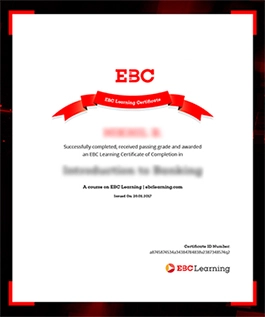Advanced Due Diligence for Private Equity and M&A Transactions
Learn all aspects of creating a due diligence report, including strategic investment transactions, financial indebtedness, material agreements, real estate, insurance, IP, and litigation.

Pay via EBC Webstore
Skills you'll learn
About Course
The Legal Due Diligence course deals with various aspects of conducting legal and financial due diligence for a company. Students in this course will gain in-depth knowledge and understanding of the essential areas to be covered when conducting legal and financial due diligence for different types of transactions. The course includes essential areas of information which must be obtained as well as learning the most efficient methods of dealing with that information and how to capture it in a diligence report. Students will also learn how to identify and flag issues, and suggest plausible remedies and mitigating factors that can be included in the transaction document—like shareholders' agreement, business transfer agreement, share purchase agreement, etc. The course actively involves the students in exercises, to ensure they gain a solid working understanding of the principles and practices of thorough due diligence projects, protecting potential clients and achieving the aims of the transaction.
At the end of the course, the student will recognise:
- The essential areas of information needed to be covered
- Avoid basic errors while preparing a due diligence report
- Understand the importance and characteristics of a thorough due diligence report
- Be able to prepare a requisition list based on documents
- Be able to apply the laws in a transaction
- Approach the due diligence exercise with increased confidence
- Write clearer, fuller, more structured due diligence reports
Who should take this course?
Law Students and Recent Law Graduates, Lawyers, In-House Counsels, Legal Professionals who wish to switch to corporate practice or looking to kickstart a career as Transactional Lawyers, Chartered Accountants, Company Secretaries, Cost & Work Accountants, Government Officials, Academicians, Managers, Chief Executive Officers, Company Directors, Prospective Entrepreneurs, may take this course. The course would help launch law students into a career in corporate law and help practitioners develop their corporate law practice. Business professionals, advisors and managers interested in a detailed legal understanding of corporate affairs may take this course to hone their legal skills.

What we hope ever to do with ease, we must first learn to do with diligence.
Samuel Johnson- Part A—Due Diligence for Strategic Investment Transactions and Corporate Due Diligence
- 1. 📕 Introduction to due diligence for strategic investment transactions
- 1.1 ▸ What is due diligence?
- 1.2 ▸ When does a due diligence exercise start for a transaction?
- 1.3 ▸ What are the different types of due diligence?
- 1.4 ▸ What are the different formats of due diligence reports?
- 1.5 ▸ What information to profile in a due diligence report?
- 1.6 ▸ What is the aim of a due diligence report?
- 1.7 ▸ What is the scope of the due diligence report?
- 1.8 ▸ What are the different steps involved in due diligence?
- 1.9 ▸ Behavioural conduct during a due diligence
- 2. 📕 Corporate due diligence
- 2.1 ▸ Introduction
- 2.2 ▸ What is the scope of the corporate chapter?
- 2.3 ▸ How to prepare a requisition list for the corporate chapter?
- 2.4 ▸ How to go about making the chapter?
- 2.5 ▸ Background and incorporation details
- 2.6 ▸ Business commencement certificate
- 2.7 ▸ Special licence for section 8 company
- 2.8 ▸ Certification of recognition for a startup company
- 2.9 ▸ Issues that you may find in the background and incorporation details
- 2.10 ▸ Charter documents of a company
- 2.11 ▸ Information to be profiled from an AOA
- 2.12 ▸ Authorised share capital and paid-up share capital
- 2.13 ▸ Finding information on share capital
- 2.14 ▸ Importance of authorised share capital and paid-up share capital in different transactions
- 2.15 ▸ Shareholding pattern—Law regulating transfer of shares
- 2.16 ▸ Shareholding pattern—Rights issue
- 2.17 ▸ Shareholding pattern—Private placement
- 2.18 ▸ ESOP and sweat equity
- 2.19 ▸ Status of share certificates
- 2.20 ▸ Appointment of KMP
- 2.21 ▸ Key checkpoints for KMP appointments
- 2.22 ▸ Issues that you may find in KMP section
- 2.23 ▸ Appointment of directors
- 2.24 ▸ Assessing compliance
- 2.25 ▸ Statutory committees—Board and audit committees
- 2.26 ▸ Statutory committees—NRC, CSR, and others
- 2.27 ▸ Assessing statutory committee compliance
- 2.28 ▸ Auditors
- 2.29 ▸ Things to check for in the case of auditors
- 2.30 ▸ Unveiling the significance of resolutions in due diligence
- 2.31 ▸ Navigating board and shareholders meetings in compliance with company law
- 2.32 ▸ Resolution checklist
- 2.33 ▸ Mastering the art of summarising resolutions in due diligence
- 2.34 ▸ Annual returns and reports
- 2.35 ▸ Assessing annual returns and reports compliance
- 2.36 ▸ How to read a statutory auditor’s report?
- 2.37 ▸ How to read a statutory auditor’s report—Annexure A and Annexure B?
- 2.38 ▸ How to read a balance sheet?
- 2.39 ▸ Group companies, related parties and contingent liability
- ☆ Feedback
- I. ✒ Exercises
- 1 ✒ Exercises
- 2 ✒ Exercises
- 3 ✒ Exercises
- 4 ✒ Exercises
- 5 ✒ Exercises
- 6 ✒ Exercises
- 7 ✒ Exercises
- 8 ✒ Exercises
- 9 ✒ Exercises
- 10 ✒ Exercises
- 11 ✒ Exercises
- II. 𝍭 Index (full text of cases)
- 𝍭 Index (full text of cases)
- Part B—Financial Indebtedness
- 1. 📕 Introduction to financial indebtedness
- 1.1 ▸ What is the scope of the financial indebtedness chapter?
- 1.2 ▸ How to prepare a requisition list for the financial indebtedness chapter?
- 2. 📕 Types of loans
- 2.1 ▸ What are the different types of loans?
- 2.2 ▸ Classification of loans based on term
- 2.3 ▸ Difference between term loan and working capital loan
- 3. 📕 Guarantee and letter of credit
- 3.1 ▸ Letter of credit
- 3.2 ▸ Concept and meaning of contract of guarantee
- 3.3 ▸ Legal nature of contract of guarantee
- 3.4 ▸ Kinds of guarantee
- 3.5 ▸ Extent of surety’s liability
- 3.6 ▸ Liability of co-sureties
- 3.7 ▸ Rights of surety
- 3.8 ▸ Discharge of surety
- 3.9 ▸ Why is it important to review guarantee?
- 3.10 📚 Readings
- 3.11 ▸ Does a letter of comfort amounts to a guarantee?
- 4. 📕 What are debentures and ICDs?
- 4.1 ▸ Debentures
- 4.2 ▸ Deposits and ECBs
- 5. 📕 Pledge, mortgage and hypothecation
- 5.1 ▸ Concept and meaning of pledge
- 5.2 ▸ What are the different kinds of mortgages?
- 5.3 ▸ What is hypothecation?
- 5.4 ▸ Distinction between pledge mortgage and hypothecation
- 6. 📕 How to summarise documents?
- 6.1 ▸ How to write the financial indebtedness chapter?
- 6.2 ▸ How to summarise a loan document?—Part I
- 6.3 ▸ How to summarise a loan document?—Part II
- 6.4 ▸ How to summarise a loan document?—Part III
- 6.5 ▸ How to summarise a loan document?—Part IV
- 6.6 ▸ How to summarise a loan document?—Part V
- 6.7 ▸ How to summarise a loan document?—Part VI
- 6.8 ▸ How to summarise a loan document?—Part VII
- 6.9 ▸ How to summarise a deed of mortgage?
- 6.10 ▸ How to summarise a deed of hypothecation?
- 6.11 ▸ How to summarise a personal guarantee agreement?
- 6.12 ▸ How to summarise an inter-creditor agreement?
- 6.13 ▸ How to summarise facility agent agreement and security trustee agreement?
- 6.14 ▸ How to summarise escrow agreement?
- I. ✒ Exercises
- 1 ✒ Exercises
- 2 ✒ Exercises
- 3 ✒ Exercises
- 4 ✒ Exercises
- 5 ✒ Exercises
- 6 ✒ Exercises
- II. 𝍭 Index (full text of cases)
- 𝍭 Index (full text of cases)
- III. 📚 Readings
- 📚 Readings
- Part C—Material Agreements
- 1. 📕 Introduction to material agreements
- 1.1 ▸ What is the scope of the material agreements chapter?
- 1.2 ▸ What is material agreements?
- 1.3 ▸ How to prepare a requisition list for the material agreements chapter?
- 1.4 ▸ How to prepare the chapter on material agreements?
- 1.5 ▸ What are the things to look for in an agreement?
- 2. 📕 How to summarise documents?
- 2.1 ▸ How to summarise a material agreement?—Part I
- 2.2 ▸ How to summarise a material agreement?—Part II
- 2.3 ▸ How to summarise a material agreement?—Part III
- 2.4 ▸ How to summarise a material agreement?—Part IV
- 2.5 ▸ How to summarise a material agreement?—Part V
- 2.6 ▸ How to summarise a material agreement?—Part VI
- 2.7 ▸ How to summarise a material agreement?—Part VII
- 2.8 ▸ How to summarise a material agreement?—Part VIII
- 2.9 ▸ How to summarise a material agreement?—Part IX
- I. ✒ Exercises
- 1 ✒ Exercises
- 2 ✒ Exercises
- II. 📚 Readings
- 📚 Readings
- Part D—Real Estate
- 1. 📕 Introduction to Real Estate Chapter
- 1.1 ▸ What is the scope of the real estate chapter?
- 1.2 ▸ How to prepare a requisition list for the real estate chapter?
- 1.3 ▸ How to prepare the chapter on real estate?
- 1.4 ▸ What are the things to look for in a lease agreement or a leave and license agreement?
- 2. 📕 How to summarise a lease agreement?
- 2.1 ▸ How to summarise a lease agreement?—Part I
- 2.2 ▸ How to summarise a lease agreement?—Part II
- 2.3 ▸ How to summarise a lease agreement?—Part III
- 2.4 ▸ How to summarise a lease agreement?—Part IV
- 2.5 ▸ How to summarise a lease agreement?—Part V
- 2.6 ▸ How to summarise a lease agreement?—Part VI
- 2.7 ▸ How to summarise a lease agreement?—Part VII
- 2.8 ▸ How to summarise a lease agreement?—Part VIII
- 3. 📕 Certain legal issues that you may find while doing the real estate chapter
- 3.1 ▸ Certain legal issues that you may find while doing the real estate chapter—Part I
- 3.2 ▸ Certain legal issues that you may find while doing the real estate chapter—Part II
- 3.3 ▸ Certain legal issues that you may find while doing the real estate chapter—Part III
- I. 📚 Readings
- 📚 Readings
- II. 𝍭 Index (full text of cases)—Real Estate
- 𝍭 Index (full text of cases)
- Part E—Insurance, IP and Litigation
- 1. 📕 Introducing the Insurance Chapter
- 1.1 ▸ What is the scope of the insurance chapter?
- 1.2 ▸ How to prepare a requisition list for the insurance chapter?
- 1.3 ▸ How to make the insurance chapter?
- 1.4 ▸ What is statutory insurance?
- 1.5 ▸ Directors’ and Officers’ Insurance
- 1.6 ▸ What is endorsement in an insurance policy?
- 1.7 ▸ What needs to be profiled from the insurance policy?
- 2. 📕 Introduction to Intellectual Property
- 2.1 ▸ Introduction to copyright and trademark
- 2.2 ▸ Introduction to patent and trade secret
- 2.3 ▸ What is the scope of the Intellectual property chapter?
- 2.4 ▸ How to make a preliminary requisition list for the intellectual property chapter?
- 2.5 ▸ Overview of copyright
- 2.6 ▸ Overview of trademarks
- 2.7 ▸ What are the things to look for in trademarks?
- 2.8 ▸ Overview of patents
- 2.9 ▸ Overview of trade-secrets
- 2.10 ▸ Certain software licenses
- 3. 📕 Litigation
- 3.1 ▸ What is the scope of the litigation chapter?
- 3.2 ▸ How to prepare a requisition list for the litigation chapter?
- 3.3 ▸ How to prepare the chapter on litigation?
- 3.4 ▸ What information to profile?
- 4. 📕 Approvals and Clearances and HR
- 4.1 ▸ What are approvals and clearances, and why are they important?
- 4.2 ▸ What is the scope of approval and clearance and HR chapter?
- 4.3 ▸ How to prepare a requisition list for approval and clearance and HR chapter?
- 4.4 ▸ Understanding the labour laws—Part I
- 4.5 ▸ Understanding the labour laws—Part II
- 4.6 ▸ Applicability of the labour laws—Part I
- 4.7 ▸ Applicability of the labour laws—Part II
- 4.8 ▸ Applicability of the labour laws—Part III
- 4.9 ▸ Applicability of the labour laws—Part IV
- 4.10 ▸ Understanding the environmental laws
- 4.11 ▸ What are the things to profile from the licenses and approvals?
- 4.12 ▸ How to make this chapter? Part I
- 4.13 ▸ How to make the consent and approval chapter? Part II
- 4.14 ▸ How to make the HR chapter? Part III
- 5. 📕 Conclusion
- 5.1 ▸ Conclusion
- I. ✒ Exercises
- 1 ✒ Exercises
- 2 ✒ Exercises
- 3 ✒ Exercises
- ☆ Feedback
Instructors

Juhi Roy
Instructor, EBC Learning
Juhi Roy has previously worked as a Senior Associate in the General Corporate team of Argus Partners, Kolkata. She has also worked with Cyril Amarchand Mangaldas, Mumbai; Network 18 Media and Investments Limited, Mumbai; Wadia Ghandy & Co., Mumbai; and SA Partners, Mumbai.

Diligence is the mother of good fortune, and the goal of a good intention was never reached through its opposite, laziness.
Miguel de CervantesCertificate
Complete this course and exercises to earn a certificate. Share it with your friends, colleagues, and employers.*
*You must Subscribe to get a certificate.

Limit Reached or Trial Expired
You have reached the limit of 2 audit enrollments or your trial period has expired.
